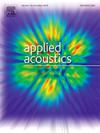Effects of multi-divisional driving using a linear array transducer on microbubble backscattering
IF 3.4
2区 物理与天体物理
Q1 ACOUSTICS
引用次数: 0
Abstract
Contrast-enhanced ultrasound imaging (CEUS) employs ultrasound contrast agents (UCAs) for diagnostic purposes. Despite its effectiveness in lesion detection, the low signal-to-noise ratio (SNR) limits its utility in deep tissue and small vessel imaging. To address this limitation, we propose a novel driving method for a linear array transducer to improve the backscattering property from microbubbles. This method involves dividing array elements into two or three segments and driving them in opposite phases between adjacent segments, referred to in this paper as 2-division and 3-division driving, respectively. To assess the effectiveness of this driving method, we experimentally define and study the backscattering coefficient of microbubbles. Additionally, we conduct dynamic simulations of microbubble behavior to validate the experimental results. The microbubbles were sonicated at 1.38 MHz while varying the inter-bubble distance (IBD). The results from both experiments and simulations demonstrate that 3-division driving yields the highest backscattering coefficient across all IBD values. This suggests that multidivisional driving could enhance deep tissue and small vessel imaging.

求助全文
约1分钟内获得全文
求助全文
来源期刊

Applied Acoustics
物理-声学
CiteScore
7.40
自引率
11.80%
发文量
618
审稿时长
7.5 months
期刊介绍:
Since its launch in 1968, Applied Acoustics has been publishing high quality research papers providing state-of-the-art coverage of research findings for engineers and scientists involved in applications of acoustics in the widest sense.
Applied Acoustics looks not only at recent developments in the understanding of acoustics but also at ways of exploiting that understanding. The Journal aims to encourage the exchange of practical experience through publication and in so doing creates a fund of technological information that can be used for solving related problems. The presentation of information in graphical or tabular form is especially encouraged. If a report of a mathematical development is a necessary part of a paper it is important to ensure that it is there only as an integral part of a practical solution to a problem and is supported by data. Applied Acoustics encourages the exchange of practical experience in the following ways: • Complete Papers • Short Technical Notes • Review Articles; and thereby provides a wealth of technological information that can be used to solve related problems.
Manuscripts that address all fields of applications of acoustics ranging from medicine and NDT to the environment and buildings are welcome.
 求助内容:
求助内容: 应助结果提醒方式:
应助结果提醒方式:


